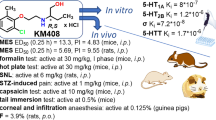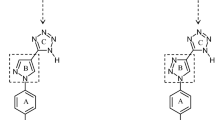Abstract
Current centrally acting analgesics such as opioids are associated with adverse effects that limit their use and threaten patient safety. Isovaline is a novel prototype analgesic that produces peripheral antinociception in several pain models with little or no effect on the central nervous system. The aim of this study was to establish a preliminary structure–activity relationship for isovaline derivatives by assaying efficacy in the formalin foot assay and central adverse effect profile in mice. Selected compounds were tested using the formalin foot assay to determine efficacy in reducing formalin-induced behaviors. Of the compounds tested, R-isovaline, S-isovaline, and 1-amino-1-cyclobutanecarboxylic acid reduced nocifensive behavior in phase II of the assay. These effects occurred without affecting performance on the rotarod, indicating that the reduction in nocifensive behaviors was not due to sedation or motor incoordination. Modifications to isovaline that increased its steric size without a cyclobutane ring formation produced compounds with no activity in the formalin foot assay. These findings indicate that the conformational stability of isovaline or the ability to form a cyclobutane ring is necessary for activity in the formalin foot assay.








Similar content being viewed by others
References
Asseri KA et al (2015) Group II metabotropic glutamate receptor antagonism prevents the antiallodynic effects of R-isovaline. Neuroscience 293:151–156
Balerio GN, Rubio MC (2002) Baclofen analgesia: involvement of the GABAergic system. Pharmacol Res 46(3):281–286
Bennett GJ (2000) Update on the neurophysiology of pain transmission and modulation: focus on the NMDA-receptor. J Pain Symptom Manage 19(1 Suppl):S2–S6
Butts JS, Sinnhuber RO (1941) Studies in amino metabolism: VI. The metabolism of dl-valine and dl-isovaline in the normal rat. J Biol Chem 139:963–969
Capacio BR et al (1992) Use of the accelerating rotarod for assessment of motor performance decrement induced by potential anticonvulsant compounds in nerve agent poisoning. Drug Chem Toxicol 15(3):177–201
Cavalcante Melo FH et al (2012) Antinociceptive activity of carvacrol (5-isopropyl-2-methylphenol) in mice. J Pharm Pharmacol 64(12):1722–1729
Chizh BA, Headley PM, Tzschentke TM (2001) NMDA receptor antagonists as analgesics: focus on the NR2B subtype. Trends Pharmacol Sci 22(12):636–642
Chung CC (2009) Effects of isovaline and ACBC on tonic and acute nociceptive models in rodents. MSc thesis, The University of British Columbia, Vancouver, Canada
Cooke JE, Mathers DA, Puil E (2009) Isovaline causes inhibition by increasing potassium conductance in thalamic neurons. Neuroscience 164(3):1235–1243
Cooke JE, Mathers DA, Puil E (2012) R-isovaline: a subtype-specific agonist at GABA B-receptors? Neuroscience 201:85–95
Cvrček P (2008) Side effects of ketamine in the long-term treatment of neuropathic pain. Pain Med 9(2):253–257
Gaillard S et al (2014) GINIP, a Gαi-Interacting protein, functions as a key modulator of peripheral GABAB receptor-mediated analgesia. Neuron 84(1):123–136
Greco CM et al (1980) Cycloleucine encephalopathy. Neuropathol Appl Neurobiol 6(5):349–360
Harrold MW, Zavod RM (2013) Basic concepts in medicinal chemistry, 1st edn. American Society of Health-System Pharmacists, Bethesda
Hewitt D (2000) The use of NMDA-receptor antagonists in the treatment of chronic pain. Clin J Pain 16:S73–S79
Inanobe A, Furukawa H, Gouaux E (2005) Mechanism of partial agonist action at the NR1 subunit of NMDA receptors. Neuron 47(1):71–84
Kerr DI, Ong J, Prager RH (1990) Antagonism of GABAB-receptor-mediated responses in the guinea-pig isolated ileum and vas deferens by phosphono-analogues of GABA. Br J Pharmacol 99(2):422–426
Kim SJ et al (1999) Sex differences in late behavioral response to subcutaneous formalin injection in mice. Brain Res 829(1–2):185–189
Lee IO et al (2013) Evaluation of a novel mouse model of intracisternal strychnine-induced trigeminal allodynia. Can J Anesth 60(8):780–786
MacLeod BA et al (2010) Analgesic properties of the novel amino acid, isovaline. Anesth Analg 110(4):1206–1214
Mao J (2012) Current challenges in translational pain research. Trends Pharmacol Sci 33(11):568–573
Nixon R (1976) Neurotoxicity of a non-metabolizable amino acid, 1-aminocyclopentane-1-carboxylic acid (ACPC): ACPC transport mechanisms in tissues. Biochem Pharmacol 25:726–729
Petrenko AB et al (2003) The role of N-methyl-d-aspartate (NMDA) receptors in pain: a review. Anesth Analg 97(4):1108–1116
Rustay NR, Wahlsten D, Crabbe JC (2003) Influence of task parameters on rotarod performance and sensitivity to ethanol in mice. Behav Brain Res 141(2):237–249
Shiba K, Mori H, Hisada K (1989) Analogues of alpha-aminoisobutyric acid with various alkyl groups as potential tumour imaging agents; effects of chain length on tumour and normal tissue specificity. Nucl Med Commun 10:751–758
Tjølsen A et al (1992) The formalin test: an evaluation of the method. Pain 51(1):5–17
Vorobeychik Y, Willoughby CD, Mao J (2013) NMDA receptor antagonists in the treatment of pain. In: Deere TR et al (eds) Comprehensive treatment of chronic pain by medical, interventional, and integrative approaches. American Academy of Pain Medicine, pp 61–67
Watson GB et al (1989) Glycine antagonist action of 1-aminocyclobutane-1-carboxylate (ACBC) in Xenopus oocytes injected with rat brain mRNA. Eur J Pharmacol 167(2):291–294
Whitehead RA et al (2012) GABA B receptor-mediated selective peripheral analgesia by the non-proteinogenic amino acid, isovaline. Neuroscience 213:154–160
Whitehead RA et al (2015) The efficacy and safety of the novel peripheral analgesic isovaline as an adjuvant to propofol for general anesthesia and conscious sedation. Anesth Analg 121(6):1481–1487
Acknowledgements
Support was provided in part by the Dr. Jean Templeton Hugill Endowment for Anesthesia Memorial Fund; Dr. Schwarz holds the Dr. Jean Templeton Hugill Chair in Anesthesia (The University of British Columbia; Vancouver, British Columbia, Canada).
Author information
Authors and Affiliations
Corresponding author
Ethics declarations
Conflict of interest
TF, YA, RW, and SKWS have no conflict of interests to declare. EP is co-holder of a patent on the use of isovaline as an analgesic and CEO of TherExcell Pharma Inc. which is developing isovaline as a clinical analgesic. BM is a co-holder of a patent on the use of isovaline as an analgesic and a major shareholder as well as member of the board of directors for TherExcell Pharma Inc.
Ethical approval
All procedures performed in studies involving animals were in accordance with the ethical standards of the institution or practice at which the studies were conducted.
Additional information
Handling Editor: T. Harkany.
Rights and permissions
About this article
Cite this article
Fung, T., Asiri, Y.I., Wall, R. et al. Variations of isovaline structure related to activity in the formalin foot assay in mice. Amino Acids 49, 1203–1213 (2017). https://doi.org/10.1007/s00726-017-2421-6
Received:
Accepted:
Published:
Issue Date:
DOI: https://doi.org/10.1007/s00726-017-2421-6




